

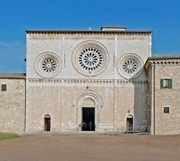
San Pietro and St Victorinus
The foundation of this abbey outside the Roman walls of Assisi is closely linked to the martyrdom of St Victorinus and his companions in the the 3rd century:
-
✴One of the companions was beheaded and another two were thrown into a well. According to tradition, this was the so-called well of the two martyrs, which is now in that part of the monastery that houses the Museo di San Pietro.
-
✴St Victorinus was then beheaded by a bridge on the Tescio that became known as Ponte San Vittorino (see Around Assisi). The Monastero di San Vittorino was on the site of the martyrdom of St Victorinus and originally housed his relics. San Vittorino was documented in the 14th century as a priory dependent upon San Pietro, and the two monasteries were probably always closely linked.
Relics of St Victorinus
The relics were translated from San Vittorino to San Pietro at an unknown date. They were preserved under its high altar until 1642, when Bishop Malatesta Baglioni arranged for their translation to a side altar. In 1954, the relics were placed in a Roman sarcophagus and returned to the high altar (see below).
History of San Pietro
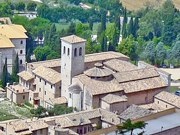
The abbey was first documented in 1029, and the crypt (now part of the Museo di San Pietro) probably dates to around this time. The abbey acquired extensive properties in and around Assisi, and played an important part in the political life of the city.
The church was rebuilt in the 13th century: Pope Innocent IV consecrated its successor in 1253 and the facade was completed in 1268 (see below).
San Pietro was within the new circuit of walls built around Assisi at some time after 1316.
In 1433, the abbey passed in commendam to the young Latino Orsini (who became a cardinal in 1448). In 1577, Pope Gregory XIII expelled the monks and San Pietro became a parish church. However, in 1613, Pope Paul V gave it to a community of monks from San Pietro, Perugia, who belonged to the Cassinese Congregation of the Benedictine Order.
The abbey was suppressed in 1866 and served as a school of agriculture. The abbey was returned to the Cassinese Congregation in ca. 1918.
Exterior
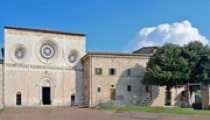
The inscription that runs across the fine Romanesque facade of the church (under the cornice across above the lower storey) records that the the facade was completed in 1268 , in the time of the Abbot Rustico. Its tympanum was removed in the 19th century after it had been damaged in an earthquake. The two lateral rose windows, which are probably original, are only useful for decoration, since side aisles behind them are lower than the façade.
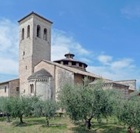
The abbey extends to the the sides of the church and behind it.
Interior
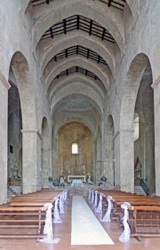
Rectangular pillars separate the nave from the two barrel-vaulted aisles.
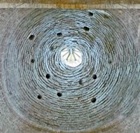
Two chapels flank and communicate with the presbytery in the manner of Byzantine churches:
-
✴that on the left (the prothesis) was used for receiving and blessing offerings before the Mass; and
-
✴that on the right (the diaconicon) was used for the robing of the priest and other officiants. This second chapel was subsequently rebuilt as the present sacristy.
The Cappella del SS Sacramento, to the left of the left transept, dates to the 14th century.
The interior of the church was decorated in the Baroque style in the 17th century, probably in 1642 when the relics of St Victorinus were translated to a side altar.
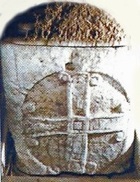
The church was restored again after the earthquake of 1997.
Funerary Monuments
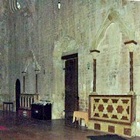
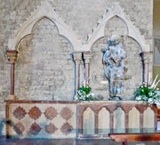
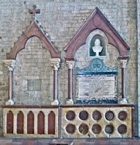
Another four broadly contemporary monuments are on the side walls of the presbytery;
-
✴two on the left; and
-
✴two on the right.
Frescoes in the Prothesis (13th century)
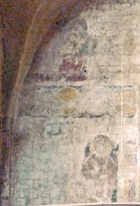
-
✴a Madonna and Child above the frieze; and
-
✴a standing saint below it.
Frescoes in the Cappella del Sacramento (14th century)
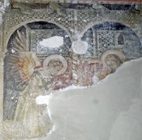
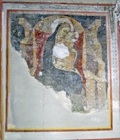

These damaged frescoes are attributed to Pace di Bartolo. They depict:
-
✴the Annunciation (to the left on the back wall);
-
✴the Madonna and Child (to the right on the back wall); and
-
✴St Victorinus (on the right wall).
SS Benedict, Cyril and Methodius (mid 13th century)
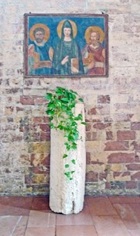
Madonna del Rosario (1611)
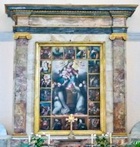
Crypt
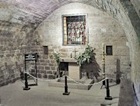
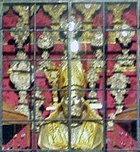
Art from the Church
Madonna and Child with saints (ca. 1468)
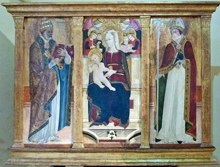
This altarpiece depicts the Madonna and Child with musical angels and SS Peter and Victorinus. It is signed by Matteo da Gualdo and dated 14... in the inscription on the throne. (The date of 1468 is assumed on stylistic grounds, with reference to Matteo’s securely dated frescoes in the Oratorio dei Pellegrini). The inscription under the throne records the name of the donor, Abbot Bartolomeo.
The altarpiece was first documented in 1872 [in San Pietro]. It was exhibited in Perugia in 1907, but was substituted, perhaps during the exhibition, by a good copy. The original was recovered from a private collection in Rome in 1912. It was then returned to San Pietro and placed in the monastery chapel. It is now in the Museo di San Pietro.

